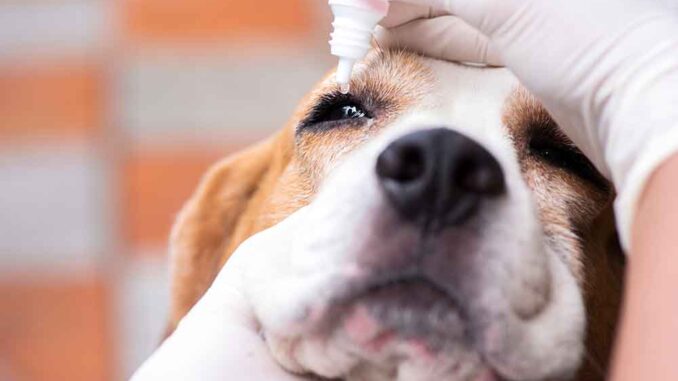
This article was updated on March 5th, 2023
The eyes are important and delicate organs. Unfortunately, they’re not immune to infections and other issues. Actually, eye infections are quite common. So much so, that not a week goes by that I don’t see a red-eyed and weepy dog in need of assistance. Most eye infections are going to require veterinary treatment, but there are a few at-home remedies that can be tried in minor cases.
What Do Eye Infections in Dogs Look Like?
Eye infections in dogs are irritating if not downright painful. With this in mind, most of the signs of dog eye infections shouldn’t be too surprising. This is what you might see:
- Redness of the eye or surrounding tissue
- Swelling surrounding eye
- Squinting, blinking or holding the eye shut
- Watering or tearing
- Thick, colored discharge
- Scratching, pawing, or rubbing eye
- Light sensitivity
View our article featuring 14 pictures of dog eye infections, or keep scrolling.
How to Treat Dog Eye Infections at Home

Your dog’s eyes are nothing to mess around or experiment with. If you suspect that your pup has an eye infection, contact your veterinarian right away. While you wait for that appointment, you may try the following steps to provide your dog with a little relief.
1. Flush your dog’s eye with saline solution or a dog eye wash. Avoid human products as these may cause reactions. This may help dogs that just have a little redness and discharge. You can flush your dog’s eyes 2-3 times per day. Some good products for doing this include Vetricyn Plus All Animal Eye Wash and NutriVet Eye Rinse.
2. For swelling around the eye, a cold compress can provide some relief. Apply the cold compress for 10-15 minutes three to four times per day.
3. Wipe the discharge from their eyes and skin with a warm, moist washcloth to prevent further eye irritation and skin infections. If you’re looking for a product that will remove the excess moisture and help prevent tear staining on the hair, try Miracle Care Eye Wash Solutions.
4. If you can see a foreign object in your dog’s eye and can remove it without causing further injury, you may try to remove it. Keep in mind that most foreign objects require sedation to safely remove, so don’t do anything that might hurt your pup further.
5. See your vet if your dog is showing any pain, such as constant blinking, squinting or pawing their eye. If redness, discharge, and swelling don’t get better after rinsing and cold compresses, see your vet.
To learn more, read our post about the best dog eye drops (or keep reading):

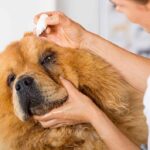
When to See a Vet for a Dog Eye Infection
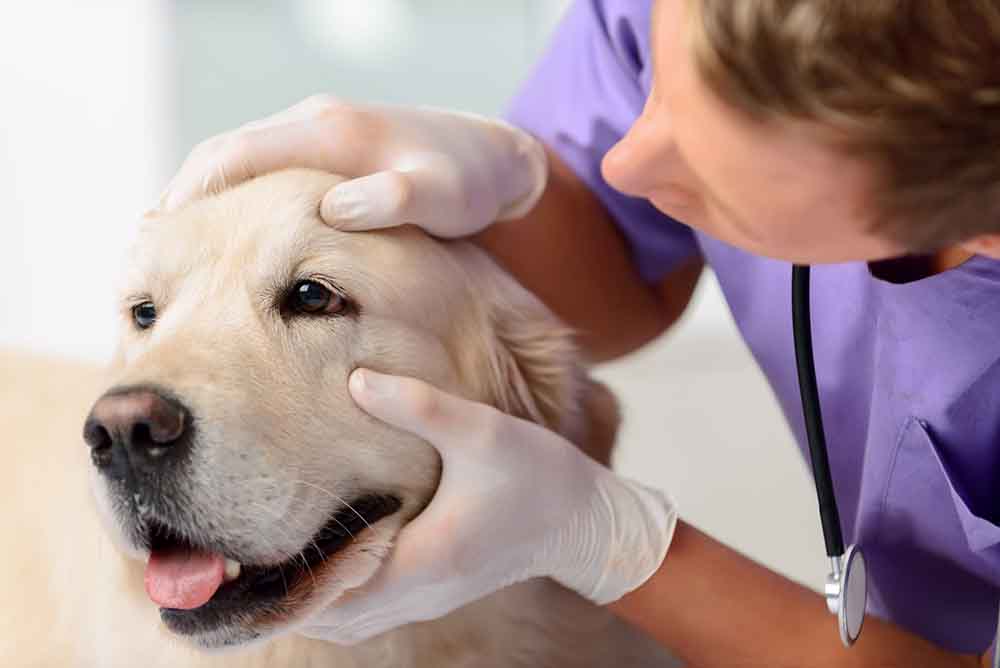
You’ll know it’s time to enlist some professional help when there’s no improvement within a day or two of the at-home treatments. Also, anytime your pup is showing pain that causes squinting, closing, or pawing, veterinary care is recommended. If you suspect a serious condition such as a corneal ulcer or uveitis, get to your vet immediately. Don’t try any at-home care with these.
Waiting to see your vet when your dog has an eye infection can cause permanent damage to the eye.
Your vet will do a complete ophthalmic exam to determine the cause of your dog’s eye infection. They may use special stains to see if there is a corneal ulcer or they may take samples of the discharge to find out what is causing the infection. Vets have the ability to prescribe medications that are designed to treat eye infections, such as antibiotics, antifungals, and anti-inflammatories, that are stronger and safer than over-the-counter products.
Can an Eye Infection in a Dog Resolve on its Own?
About the only eye issue that will resolve on its own is minor irritation caused by an allergen or other irritant. Sometimes these conditions will clear up by some dedicated flushing with saline solution or dog eye wash. True infections where bacteria, viruses, or fungi are present typically won’t resolve without medication.
The issue with not treating an eye infection is the risk for causing permanent damage to the eye. You don’t want to take a wait-and-see approach if you suspect an eye infection in your dog. Contact your vet and let them know what you think. They may give you some steps to take at home while you wait for your veterinary appointment.
At-Home Treatment Options for 5 Common Dog Eye Infections
An eye infection in dogs isn’t just an eye infection. In fact, there are many different types that will require different treatments. We have outlined below at-home and veterinarian treatment options for the most frequent ear infections in dogs.
1. Conjunctivitis
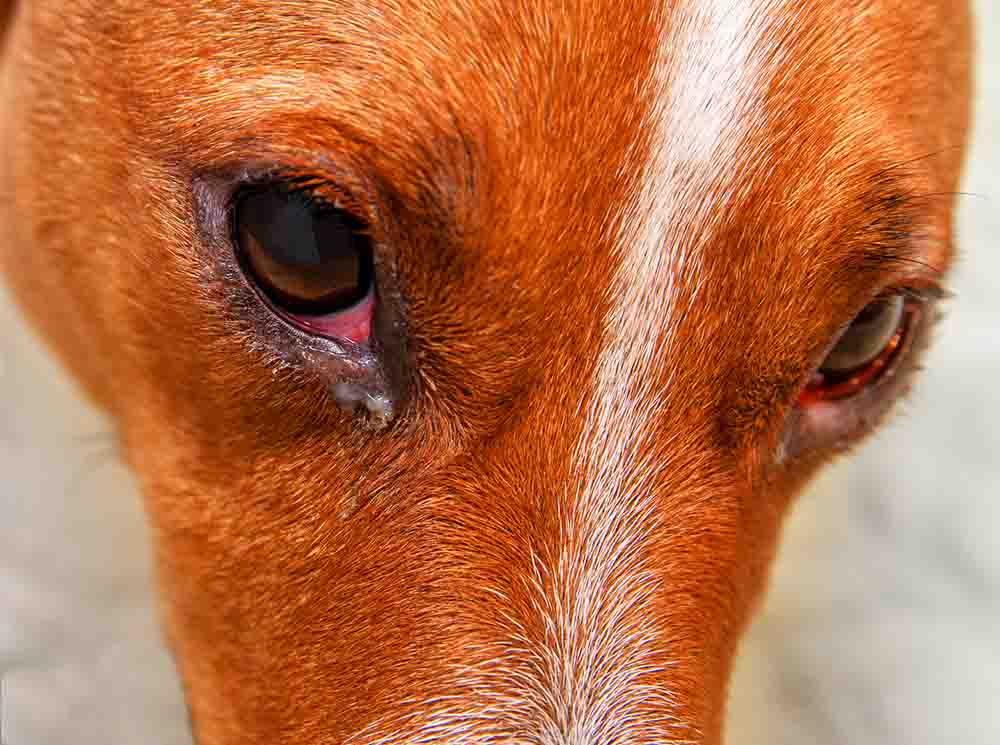
Better known as “Pink Eye”, conjunctivitis is inflammation of the lining to the eye lids and the thin covering of the eyeball. It can be caused by a viral, bacterial, or fungal infection or by irritants or allergies. Dogs will usually have red, swollen tissues around the eye and redness to the eyeball itself. Conjunctivitis can range from mild to severe, depending on the cause.
How to treat at home: Mild cases may be treated at home by flushing the eye 2-3 times a day with a sterile saline solution or eye wash.
More severe cases, especially those that are showing squinting or blinking, should have veterinary treatment. Prescription antibiotic dog eye drops will often cure most cases of conjunctivitis. More severe cases will benefit from anti-inflammatories as well.
2. Keratitis
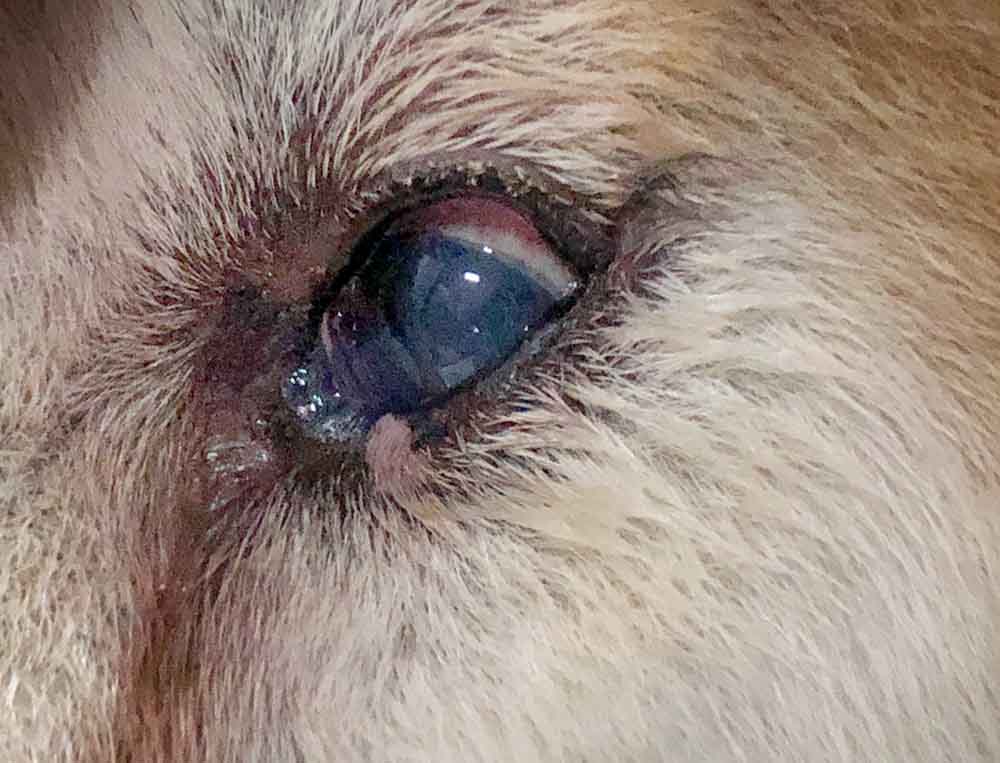
Keratitis is inflammation or infection of the clear part of the eye, known as the cornea. This type of eye infection can be caused by a virus, bacteria or fungus. Affected eyes will be watery, red, and may have a thick, colored discharge. The eyeball itself may also appear blue. Dogs may rub or paw at their eye, which can lead to injuries.
Is treatment at home a good option? we do not recommend treatment at home. Keratitis should be treated with prescription eye drops from your veterinarian. Samples may need to be taken to determine if the infection is caused by a bacteria or fungus in order to provide the right medication.
Most cases of keratitis will clear up with proper treatment, however some cases may lead to corneal injuries which can become very serious if left untreated.
3. Corneal ulcers
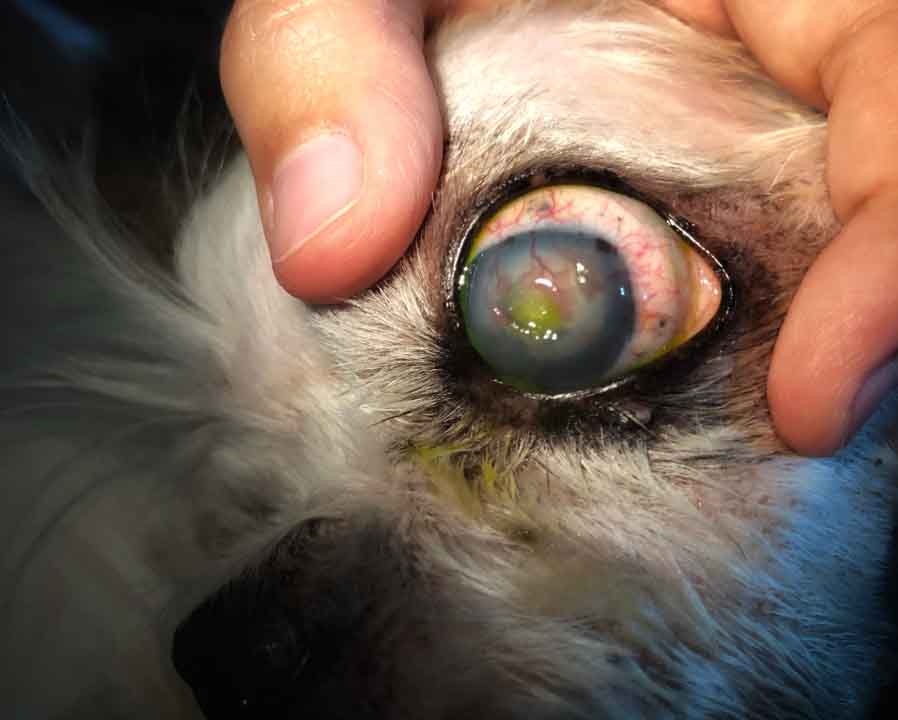
While not technically an eye infection on its own, corneal ulcers have the potential to become infected and very serious. Corneal ulcers can lead to loss of the eye if they aren’t treated properly. Corneal ulcers are holes or abrasions to the clear part of the eye, usually caused by trauma. Bacteria or viruses can move in and cause an infection in the ulcerated part of the eye. Corneal ulcers are painful, causing dogs to squint, have light sensitivity, and to paw or rub their eye. They will have watery or colored discharge and the eye will look blue or like a spiderweb of red as it heals.
Is treatment at home a good option? Don’t mess around with corneal ulcer infections. These need to be treated by a veterinarian with eye drops and potentially surgery. Even minor corneal ulcers can lead to big trouble without treatment.
4. Cherry eye
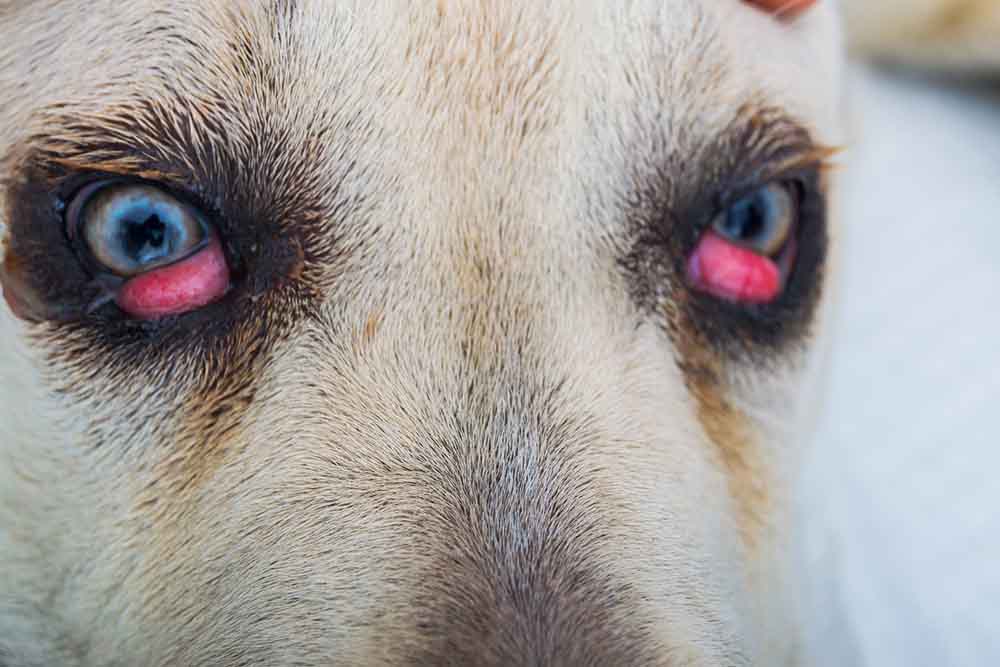
This is rather the cause of an eye infection, not the infection itself. Cherry eye is when the tear-producing gland located in the inner corner of the eye slips out from under the third eyelid and is visible in the eye. This may cause inflammation that blocks tear ducts and leads to infection. Dogs will show up with a bright red bump in the inner corner of their eye. They’re usually not painful but may rub or paw at it. They may also have colored discharge.
How to treat at home: Cherry eye can sometimes be relieved at home by decreasing the swelling with cold packs. However, this is often a temporary fix and veterinary care will be needed.
Veterinarians will treat with antibiotic eyedrops and a surgical fixture of the gland back in place. This gland is responsible for about half of the eye’s tear production, so if left untreated, chronic dry eye can occur.
5. Uveitis
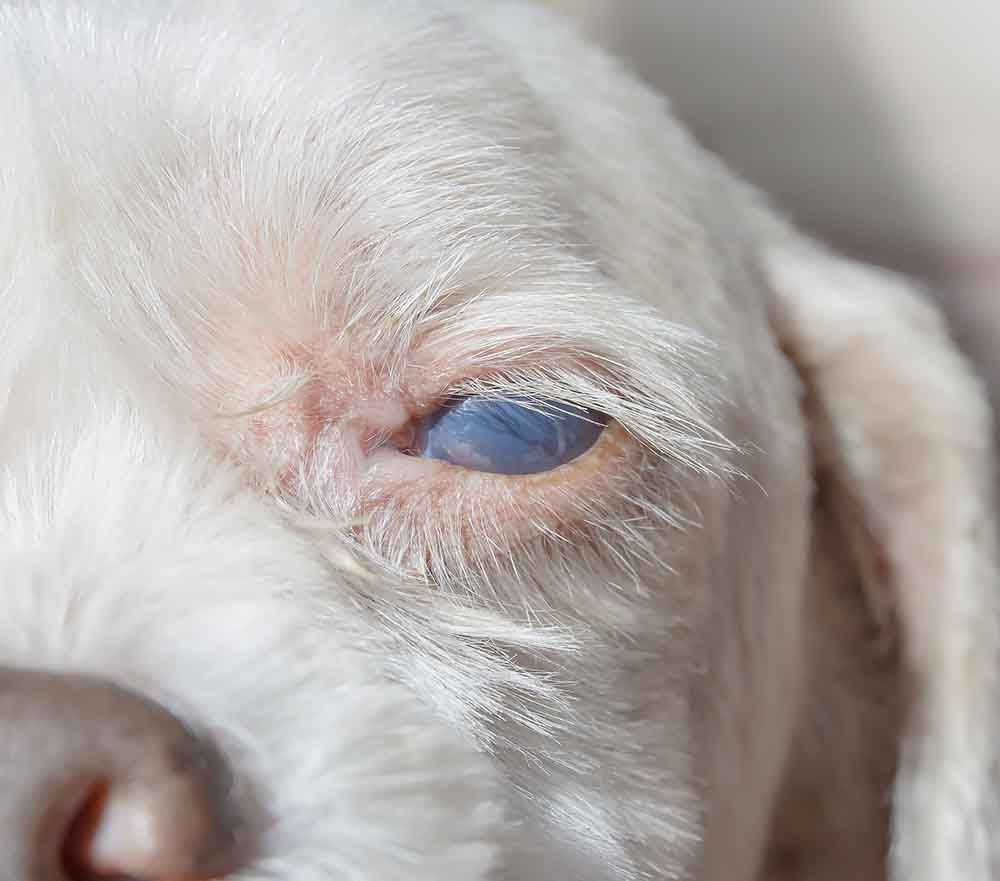
Now let’s get to the inner parts of the eye. The uvea refers most of the structures we see inside the eye, including the iris. Inflammation of these structures can be caused by infections. Dogs with uveitis are very painful and will keep their eye closed when possible. They have extreme light sensitivity and a lot of tearing. Eyes may appear cloudy or have blood or pus visible inside.
Is treatment at home a good option? Don’t try to treat this at home as it can lead to permanent damage to the eye. See your veterinarian for medicated dog eye drops and anti-inflammatories. Some cases may need a referral to a veterinary ophthalmologist.
Common Causes of Eye Infections in Dogs
There are many things that don’t mind setting up shop in your dog’s eyes. Eye infections can be caused by any of the following:
- Viruses-most commonly herpes, canine influenza, hepatitis or distemper. Usually causes a clear, watery discharge.
- Bacteria-brucellosis, leptospirosis or Lyme’s disease are the common culprits. Often shows up with a thick, colored discharge.
- Fungi- Found in the environment, fungal spores can cause eye infections.
- Injuries-Dogs are curious and like to get their faces right in things which can sometimes lead to abrasions or punctures of the eye that disrupt the natural barriers of the eye and may become infected.
- Irritants or allergens-Anything that can irritate the eye can cause infections. This includes pollen, smoke, or soaps.
- Foreign object-Remember that element of curiosity? It can also bring about foreign objects, such as grass seeds or dirt, in the eye that can lead to an infection.
Preventing Dog Eye Infections and Keeping Your Dog’s Eyes Healthy
Some dogs just can’t help but get their noses into things. This just increases the chances of getting irritants or injuries to their eyes. For those dogs, knowing the initial signs of an eye infection will help you treat it before it becomes a real issue.
You may help decrease eye infections by trimming the long hairs around the eyes to keep them from causing constant irritation. You may also choose to flush your pup’s eyes with saline solution or dog eye wash after an outing, bath, or hair cut to help remove potential irritants.
For dogs that naturally have some excessive tearing, mainly those short-nosed, “bulgy” eye breeds, use a warm, moist washcloth or eye wipe to remove excess moisture and prevent tear staining.
Not All Eye Problems Are Infections
Watery, red eyes are commonly due to an eye infection, but not always. There are other conditions that may be mistaken for an eye infection, so it’s important to see your veterinarian for a proper diagnosis. Those conditions include:
- Glaucoma
- Tear duct blockage or defect
- Eye defects, such as entropion
- Dry eye
- Tumors
- Allergies: these are different from infections in that there isn’t a viral, bacterial or fungal component. Diagnosis should involve a veterinary exam.
FAQ About Eye Infections in Dogs
Which breeds are prone to eye infections?
Dog breeds that are prone to eye infections are typically those short-nosed dogs with “bulgy” eyes. Think pugs, Boston Terriers, and Shih Tzus. There are also breeds that are prone due to genetic malformations in the eyes, such as Cocker Spaniels.
Is dog conjunctivitis contagious?
Conjunctivitis that is caused by a viral or bacterial infection is contagious to other dogs. Pups that come in close proximity to an infected dog’s eye or the discharge from it are most at risk.
Can I get conjunctivitis from my dog?
Most cases of conjunctivitis in dogs are caused by species-specific organisms that can’t infect humans. However, you can never be too careful. Be sure to wash your hands before and after treating your dog or wiping discharge.
Related posts about dog eye infections:
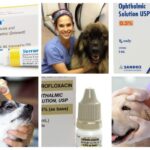

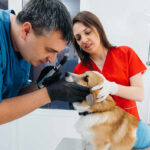

Disclaimer: This website's content is not a substitute for veterinary care. Always consult with your veterinarian for healthcare decisions. Read More.


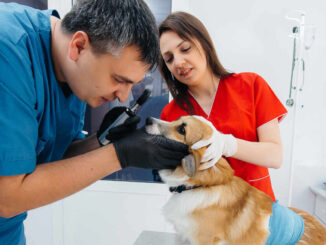
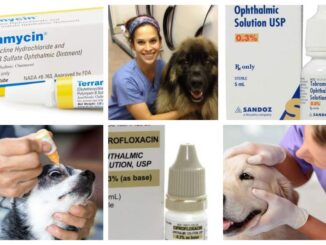
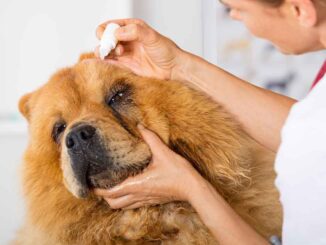
Be the first to comment